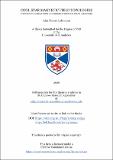Files in this item
Cool star magnetic field topologies : connecting simulations and observations for solar-like stars
Item metadata
| dc.contributor.advisor | Jardine, Moira | |
| dc.contributor.author | Lehmann, Lisa Theres | |
| dc.coverage.spatial | xxix, 185 p. | en_US |
| dc.date.accessioned | 2020-07-28T15:57:59Z | |
| dc.date.available | 2020-07-28T15:57:59Z | |
| dc.date.issued | 2020-07-27 | |
| dc.identifier.uri | https://hdl.handle.net/10023/20354 | |
| dc.description.abstract | Good knowledge about cool star magnetic activity, topology and cycles is crucial to find a second solar system and to better understand ours. The Zeeman-Doppler-Imaging (ZDI) surveys, which unveil the stellar magnetic field topology, have now run for long enough to detect solar-like activity cycles. This is a good point to review what ZDI detects robustly and how to interpret the resulting ZDI maps. As ZDI only detects the large-scale magnetic field an important question to answer is: What can we learn from the large-scale field topology about the small-scale field for solar-like stars? I connect 3D non-potential flux transport simulations based on the Sun with the observational ZDI technique. First, I decomposed the magnetic field topology of the simulations into different length-scales. I discovered that the large-scale field reflects global properties of the small-scale field emergence for slowly-rotating solar-like stars. Second, I used synthetic line profiles modelled from the simulations as input for ZDI. I showed that ZDI can recover the hints of the small-scale flux emergence in the observable large-scale field for slow rotators but recovers approximately one order of magnitude lower magnetic energy. The maximum entropy regularisation used in ZDI prevents the correct reconstruction of the magnetic energy distribution but ZDI can recover the fractions of the different field components reasonably well. To examine if ZDI can recover solar-like cycles, I applied ZDI to non-potential flux transport simulations modelling the solar magnetic field over 15 years. I discovered that the axisymmetric poloidal fraction and the axi- and non-axisymmetric energy are the best parameters to track solar-like activity cycles while the averaged large-scale field or the total energy show no or misleading trends. | en_US |
| dc.description.sponsorship | "I acknowledge support from the Scottish Universities Physics Alliance (SUPA) prize studentship and the University of St Andrews Higgs studentship. Further, I received supplementary founding for travelling from SUPA and the European Southern Observatory (ESO) for a 8-weeks short term visit at the ESO Headquarters in 2017 and the ESO for supporting a second visit (1-month) in 2018. Further, I received a travel grant to visit the Cool Stars 20 Conference in Boston to present the work displayed in Chapter 4 from the Royal Astronomical Society (RAS)." -- Funding | en |
| dc.language.iso | en | en_US |
| dc.publisher | University of St Andrews | |
| dc.relation | Connecting simulations and observations for solar-like stars (thesis data) Lehmann, L.T., University of St Andrews, 2019. DOI: https://doi.org/10.17630/ae078167-03ea-4af6-9055-c3147e13c286 | en |
| dc.relation.uri | https://doi.org/10.17630/ae078167-03ea-4af6-9055-c3147e13c286 | |
| dc.rights | Creative Commons Attribution-NonCommercial-NoDerivatives 4.0 International | * |
| dc.rights.uri | http://creativecommons.org/licenses/by-nc-nd/4.0/ | * |
| dc.subject | Magnetic fields | en_US |
| dc.subject | Stars | en_US |
| dc.subject | Sun | en_US |
| dc.subject | Zeeman-Doppler-imaging | en_US |
| dc.subject | Spectropolarimetry | en_US |
| dc.subject.lcc | QB843.C6L4 | |
| dc.subject.lcsh | Cool stars | en |
| dc.subject.lcsh | Stars--Magnetic fields--Computer simulations | en |
| dc.subject.lcsh | Stars--Magnetic fields--Observations | en |
| dc.subject.lcsh | Sun | en |
| dc.title | Cool star magnetic field topologies : connecting simulations and observations for solar-like stars | en_US |
| dc.type | Thesis | en_US |
| dc.contributor.sponsor | Scottish Universities Physics Alliance (SUPA) | en_US |
| dc.contributor.sponsor | University of St Andrews | en_US |
| dc.type.qualificationlevel | Doctoral | en_US |
| dc.type.qualificationname | PhD Doctor of Philosophy | en_US |
| dc.publisher.institution | The University of St Andrews | en_US |
| dc.identifier.doi | https://doi.org/10.17630/10023-20354 |
The following licence files are associated with this item:
This item appears in the following Collection(s)
Except where otherwise noted within the work, this item's licence for re-use is described as Creative Commons Attribution-NonCommercial-NoDerivatives 4.0 International
Items in the St Andrews Research Repository are protected by copyright, with all rights reserved, unless otherwise indicated.


